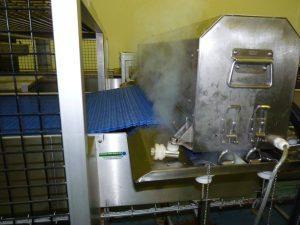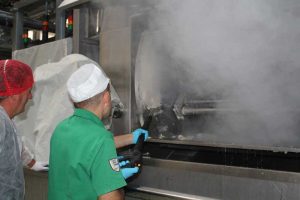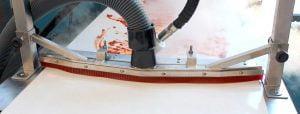Proper conveyor belt cleaning is essential for several reasons. Firstly, dirty conveyor belts can have a negative impact on productivity. When debris accumulates on the surface of the belts, it can cause friction and slippage, resulting in reduced belt speed and decreased throughput. This can lead to delays in production and increased downtime as operators have to stop the system to clean or repair the belts. By keeping the belts clean, businesses can maintain optimal productivity levels and minimize disruptions to their operations.
Secondly, maintaining clean conveyor belts is crucial for ensuring a safe work environment. When dirt and debris accumulate on the belts, they can become slippery, increasing the risk of accidents and injuries. Additionally, contaminants can get trapped in the moving parts of the conveyor system, leading to mechanical failures or breakdowns. Regular cleaning and maintenance of the belts can help prevent these issues and create a safer working environment for employees.
Common Issues with Conveyor Belt Cleaning Equipment
While conveyor belt cleaning equipment is designed to effectively remove dirt and debris from the surface of the belts, there are common issues that can arise with these machines. One common problem is inadequate cleaning. This can occur if the equipment is not properly calibrated or if the cleaning solution used is not effective in removing the specific type of dirt or debris present on the belts. Inadequate cleaning can result in residue or build-up on the belts, which can lead to reduced productivity and increased wear and tear.
Another common issue is equipment malfunction. Conveyor belt cleaning equipment consists of various components, including brushes, scrapers, and vacuum systems. If any of these components are not functioning properly, it can affect the overall performance of the machine. For example, worn-out brushes may not effectively remove dirt from the belts, while a faulty vacuum system may not adequately collect debris. Regular inspections and maintenance are essential for identifying and resolving these issues before they cause significant problems.
Troubleshooting Techniques for Conveyor Belt Cleaning Equipment
To troubleshoot issues with conveyor belt cleaning equipment, operators should follow a few key steps. Firstly, they should visually inspect the equipment to identify any obvious signs of damage or malfunction. This includes checking for worn-out brushes or scrapers, loose or damaged components, and any leaks or blockages in the vacuum system. If any issues are identified, operators should take immediate action to repair or replace the affected parts.
If no visible issues are found, operators should check the calibration of the equipment. This involves ensuring that the brushes or scrapers are making proper contact with the surface of the belts and that the vacuum system is adequately collecting debris. Adjustments may need to be made to achieve optimal cleaning results.
Regular maintenance and inspections are crucial for preventing issues with conveyor belt cleaning equipment. Operators should follow the manufacturer’s guidelines for maintenance, including cleaning and lubricating the equipment regularly. Additionally, they should schedule routine inspections to identify and address any potential issues before they cause significant problems.
Understanding Steam Vapour Cleaning Machines
| Technique | Description |
|---|---|
| Visual Inspection | Regularly inspect the conveyor belt and cleaning equipment for wear and tear, damage, and proper alignment. |
| Cleaning Schedule | Establish a regular cleaning schedule to prevent buildup of debris and contaminants on the conveyor belt and cleaning equipment. |
| Proper Cleaning Technique | Use the appropriate cleaning technique for the type of conveyor belt and cleaning equipment being used to avoid damage and ensure effective cleaning. |
| Corrective Action | Take corrective action immediately if any issues are identified during visual inspection or cleaning, such as replacing damaged parts or adjusting alignment. |
| Training | Ensure that all personnel involved in operating and maintaining the conveyor belt and cleaning equipment are properly trained and follow established procedures. |
Steam vapour cleaning machines are a popular choice for cleaning conveyor belts due to their effectiveness and efficiency. These machines use high-temperature steam to remove dirt, grease, and other contaminants from the surface of the belts. The steam is produced by heating water to a high temperature, creating a dry vapour that can penetrate deep into the pores of the belts and effectively dissolve and remove dirt.
Steam vapour cleaning machines work by delivering a controlled amount of steam onto the surface of the belts. The steam is then immediately vacuumed up, along with the dissolved dirt and debris, leaving the belts clean and dry. This method of cleaning is highly effective as it does not require the use of chemicals or excessive water, which can be damaging to the belts and the environment.
One of the main benefits of using steam vapour cleaning machines is their ability to sanitize the conveyor belts. The high-temperature steam kills bacteria, viruses, and other pathogens, ensuring a hygienic working environment. This is particularly important in industries such as food processing or pharmaceuticals where cleanliness and hygiene are critical.
Advantages of Using Steam Vapour Cleaning Machines for Conveyor Belts
There are several advantages to using steam vapour cleaning machines for conveyor belts. Firstly, these machines provide a deep and thorough clean. The high-temperature steam can penetrate deep into the pores of the belts, effectively dissolving and removing dirt, grease, and other contaminants. This ensures that the belts are thoroughly cleaned and free from residue or build-up.
Secondly, steam vapour cleaning machines are environmentally friendly. They do not require the use of chemicals or excessive water, which can be harmful to the environment. The steam is produced by heating water, and the only by-product is water vapour, which quickly evaporates. This makes steam vapour cleaning machines a sustainable and eco-friendly choice for conveyor belt cleaning.
Another advantage of using steam vapour cleaning machines is their versatility. These machines can be used on a wide range of conveyor belt materials, including rubber, PVC, and metal. They can effectively clean belts of various sizes and configurations, making them suitable for different types of conveyor systems. Additionally, steam vapour cleaning machines can be used to clean other surfaces in the facility, such as floors, walls, and equipment, providing a comprehensive cleaning solution.
How to Properly Use Automatic Conveyor Belt Steam Vacuum

Using an automatic conveyor belt steam vacuum is a straightforward process that can be easily mastered with a few simple steps. Here is a step-by-step guide on how to use this equipment effectively:
1. Prepare the machine: Before using the automatic conveyor belt steam vacuum, ensure that it is properly set up and ready for operation. This includes checking that the water tank is filled, the steam pressure is set to the desired level, and the vacuum system is functioning correctly.
2. Pre-clean the belts: Before applying steam to the belts, it is recommended to pre-clean them using a brush or scraper to remove any loose dirt or debris. This will help improve the effectiveness of the steam cleaning process.
3. Apply steam: Once the belts are pre-cleaned, activate the steam function on the machine and apply steam evenly across the surface of the belts. Move the machine slowly along the length of the belts to ensure thorough coverage.
4. Vacuum up debris: Immediately after applying steam, activate the vacuum function on the machine to collect the dissolved dirt and debris. Move the machine slowly along the length of the belts to ensure all debris is effectively collected.
5. Repeat if necessary: Depending on the level of dirt or residue on the belts, it may be necessary to repeat the steam and vacuum process multiple times to achieve optimal cleaning results. Monitor the cleanliness of the belts and continue until they are clean and free from residue.
6. Post-clean inspection: After cleaning the belts, visually inspect them to ensure that they are thoroughly cleaned and free from any remaining dirt or debris. If any areas require further cleaning, repeat the steam and vacuum process as necessary.
Maintenance Tips for Conveyor Belt Cleaning Equipment
Regular maintenance is essential for keeping conveyor belt cleaning equipment in optimal condition and prolonging its lifespan. Here are some maintenance tips to follow:
1. Clean and lubricate regularly: Clean the equipment after each use to remove any dirt or debris that may have accumulated. Additionally, lubricate moving parts, such as brushes or scrapers, to ensure smooth operation.
2. Inspect for damage: Regularly inspect the equipment for any signs of damage or wear. This includes checking for loose or damaged components, worn-out brushes or scrapers, and any leaks or blockages in the vacuum system. Address any issues immediately to prevent further damage.
3. Follow manufacturer’s guidelines: Always follow the manufacturer’s guidelines for maintenance and servicing. This includes recommended cleaning procedures, lubrication schedules, and any specific maintenance requirements for the equipment.
4. Train operators: Ensure that operators are properly trained on how to use and maintain the conveyor belt cleaning equipment. Provide them with clear instructions on proper usage, maintenance procedures, and troubleshooting techniques.
5. Schedule routine inspections: Regularly schedule inspections of the equipment to identify any potential issues before they cause significant problems. This can help prevent downtime and costly repairs.
Common Mistakes to Avoid with Conveyor Belt Cleaning Equipment
When using conveyor belt cleaning equipment, there are common mistakes that operators should avoid to achieve optimal cleaning results:
1. Inadequate cleaning: One common mistake is not cleaning the belts thoroughly enough. This can occur if the equipment is not properly calibrated or if the cleaning solution used is not effective in removing the specific type of dirt or debris present on the belts. It is important to ensure that the equipment is set up correctly and that the cleaning solution is suitable for the type of dirt or debris being removed.
2. Neglecting maintenance: Another common mistake is neglecting regular maintenance and inspections of the equipment. Regular cleaning and lubrication are essential for keeping the equipment in optimal condition and preventing issues. Additionally, routine inspections can help identify any potential issues before they cause significant problems.
3. Using excessive force: Using excessive force when cleaning the belts can cause damage to the surface or the moving parts of the conveyor system. It is important to follow the manufacturer’s guidelines for pressure settings and brush or scraper usage to avoid causing unnecessary wear and tear.
4. Ignoring safety precautions: Safety should always be a top priority when using conveyor belt cleaning equipment. Operators should follow all safety guidelines provided by the manufacturer, including wearing appropriate personal protective equipment (PPE) and ensuring that the equipment is properly grounded.
5. Rushing the cleaning process: Taking shortcuts or rushing through the cleaning process can result in inadequate cleaning and reduced effectiveness. It is important to take the time to properly clean the belts, following the recommended procedures and allowing sufficient time for steam and vacuum cycles.
Achieving Optimal Conveyor Belt Cleaning Results with Steam Vapour Machines
In conclusion, proper conveyor belt cleaning is essential for maintaining the efficiency and longevity of conveyor belts. Dirty belts can lead to reduced productivity, increased downtime, and safety hazards. By investing in high-quality conveyor belt cleaning equipment and implementing regular cleaning protocols, businesses can ensure smooth operation and a clean and safe work environment.
Steam vapour cleaning machines are an effective and efficient choice for cleaning conveyor belts. They provide a deep and thorough clean, sanitize the belts, and are environmentally friendly. By following proper usage techniques and regular maintenance, operators can achieve optimal cleaning results and prolong the lifespan of the equipment.
To achieve the best results, it is important to avoid common mistakes such as inadequate cleaning, neglecting maintenance, using excessive force, ignoring safety precautions, and rushing the cleaning process. By avoiding these mistakes and investing in high-quality conveyor belt cleaning equipment, businesses can ensure optimal cleaning results and maintain the efficiency and longevity of their conveyor belts.
FAQs
What is conveyor belt cleaning equipment?
Conveyor belt cleaning equipment is a device used to clean conveyor belts in industrial settings. It is designed to remove dirt, debris, and other contaminants from the surface of the conveyor belt to ensure smooth and efficient operation.
What are the common issues with conveyor belt cleaning equipment?
The common issues with conveyor belt cleaning equipment include belt mistracking, belt slippage, excessive wear and tear, and inadequate cleaning performance.
What causes belt mistracking?
Belt mistracking can be caused by a variety of factors, including improper installation, worn or damaged components, uneven belt tension, and material buildup on the belt.
What causes belt slippage?
Belt slippage can be caused by a lack of tension on the belt, worn or damaged pulleys, or excessive material buildup on the belt.
What causes excessive wear and tear?
Excessive wear and tear can be caused by a variety of factors, including abrasive materials, improper cleaning techniques, and worn or damaged components.
What can be done to improve cleaning performance?
To improve cleaning performance, it is important to ensure that the cleaning equipment is properly installed and maintained, that the correct cleaning solution is being used, and that the equipment is being used in accordance with the manufacturer’s instructions.
How can I troubleshoot issues with my conveyor belt cleaning equipment?
To troubleshoot issues with your conveyor belt cleaning equipment, you should first consult the manufacturer’s instructions and maintenance manual. If the issue persists, you may need to contact a qualified technician for assistance.










